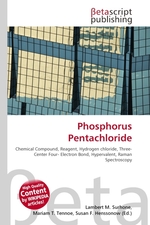Phosphorus Pentachloride
Lambert M. Surhone, Miriam T. Timpledon, Susan F. Marseken
бумажная книга
High Quality Content by WIKIPEDIA articles! In synthetic chemistry, two classes of chlorination are usually of interest. Oxidative chlorinations entail the transfer of Cl2 from the reagent to the substrate. Substitutive chlorinations entail replacement of O or OH groups with chloride. PCl5 can be used for both processes. PCl5 will convert carboxylic acids to the corresponding acyl chloride as well as alcohols to alkyl chloride. Thionyl chloride is more commonly used in the laboratory because the SO2 is more easily separated from the organic products than is POCl3. PCl5 and PCl3 bear some resemblance to SO2Cl2, as both serve often as sources of Cl2. Again for oxidative chlorinations on the laboratory scale, SO2Cl2 is often preferred over PCl5 since the gaseous SO2 by-product is readily separated. PCl5 reacts with a tertiary amides, such as DMF, to give dimethylchloromethyleneammonium chloride, which is called the Vilsmeier reagent, [(CH3)2NCClH]Cl. More typically, a related salt is generated from the reaction of DMF and POCl3.
Данное издание не является оригинальным. Книга печатается по технологии принт-он-деманд после получения заказа.


